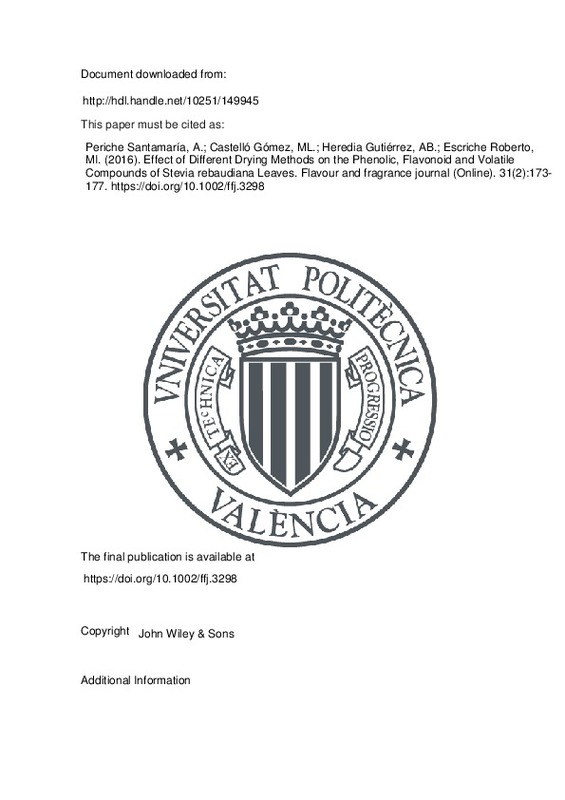Wölwer-Rieck, U. (2012). The Leaves of Stevia rebaudiana (Bertoni), Their Constituents and the Analyses Thereof: A Review. Journal of Agricultural and Food Chemistry, 60(4), 886-895. doi:10.1021/jf2044907
Lemus-Mondaca, R., Vega-Gálvez, A., Zura-Bravo, L., & Ah-Hen, K. (2012). Stevia rebaudiana Bertoni, source of a high-potency natural sweetener: A comprehensive review on the biochemical, nutritional and functional aspects. Food Chemistry, 132(3), 1121-1132. doi:10.1016/j.foodchem.2011.11.140
(2011). Revised exposure assessment for steviol glycosides for the proposed uses as a food additive. EFSA Journal, 9(1), 1972. doi:10.2903/j.efsa.2011.1972
[+]
Wölwer-Rieck, U. (2012). The Leaves of Stevia rebaudiana (Bertoni), Their Constituents and the Analyses Thereof: A Review. Journal of Agricultural and Food Chemistry, 60(4), 886-895. doi:10.1021/jf2044907
Lemus-Mondaca, R., Vega-Gálvez, A., Zura-Bravo, L., & Ah-Hen, K. (2012). Stevia rebaudiana Bertoni, source of a high-potency natural sweetener: A comprehensive review on the biochemical, nutritional and functional aspects. Food Chemistry, 132(3), 1121-1132. doi:10.1016/j.foodchem.2011.11.140
(2011). Revised exposure assessment for steviol glycosides for the proposed uses as a food additive. EFSA Journal, 9(1), 1972. doi:10.2903/j.efsa.2011.1972
Periche, A., Koutsidis, G., & Escriche, I. (2013). Composition of Antioxidants and Amino Acids in Stevia Leaf Infusions. Plant Foods for Human Nutrition, 69(1), 1-7. doi:10.1007/s11130-013-0398-1
Carbonell-Capella, J. M., Barba, F. J., Esteve, M. J., & Frígola, A. (2013). High pressure processing of fruit juice mixture sweetened with Stevia rebaudiana Bertoni: Optimal retention of physical and nutritional quality. Innovative Food Science & Emerging Technologies, 18, 48-56. doi:10.1016/j.ifset.2013.01.011
Shukla, S., Mehta, A., Mehta, P., & Bajpai, V. K. (2012). Antioxidant ability and total phenolic content of aqueous leaf extract of Stevia rebaudiana Bert. Experimental and Toxicologic Pathology, 64(7-8), 807-811. doi:10.1016/j.etp.2011.02.002
Muanda, F. N., Soulimani, R., Diop, B., & Dicko, A. (2011). Study on chemical composition and biological activities of essential oil and extracts from Stevia rebaudiana Bertoni leaves. LWT - Food Science and Technology, 44(9), 1865-1872. doi:10.1016/j.lwt.2010.12.002
Kaushik, R., Narayanan, P., Vasudevan, V., Muthukumaran, G., & Usha, A. (2010). Nutrient composition of cultivated stevia leaves and the influence of polyphenols and plant pigments on sensory and antioxidant properties of leaf extracts. Journal of Food Science and Technology, 47(1), 27-33. doi:10.1007/s13197-010-0011-7
Chatsudthipong, V., & Muanprasat, C. (2009). Stevioside and related compounds: Therapeutic benefits beyond sweetness. Pharmacology & Therapeutics, 121(1), 41-54. doi:10.1016/j.pharmthera.2008.09.007
Lin, S.-D., Sung, J.-M., & Chen, C.-L. (2011). Effect of drying and storage conditions on caffeic acid derivatives and total phenolics of Echinacea Purpurea grown in Taiwan. Food Chemistry, 125(1), 226-231. doi:10.1016/j.foodchem.2010.09.006
Hossain, M. B., Barry-Ryan, C., Martin-Diana, A. B., & Brunton, N. P. (2010). Effect of drying method on the antioxidant capacity of six Lamiaceae herbs. Food Chemistry, 123(1), 85-91. doi:10.1016/j.foodchem.2010.04.003
Capecka, E., Mareczek, A., & Leja, M. (2005). Antioxidant activity of fresh and dry herbs of some Lamiaceae species. Food Chemistry, 93(2), 223-226. doi:10.1016/j.foodchem.2004.09.020
Chan, E. W. C., Lim, Y. Y., Wong, S. K., Lim, K. K., Tan, S. P., Lianto, F. S., & Yong, M. Y. (2009). Effects of different drying methods on the antioxidant properties of leaves and tea of ginger species. Food Chemistry, 113(1), 166-172. doi:10.1016/j.foodchem.2008.07.090
Pinela, J., Barros, L., Carvalho, A. M., & Ferreira, I. C. F. R. (2011). Influence of the drying method in the antioxidant potential and chemical composition of four shrubby flowering plants from the tribe Genisteae (Fabaceae). Food and Chemical Toxicology, 49(11), 2983-2989. doi:10.1016/j.fct.2011.07.054
Abascal, K., Ganora, L., & Yarnell, E. (2005). The effect of freeze-drying and its implications for botanical medicine: a review. Phytotherapy Research, 19(8), 655-660. doi:10.1002/ptr.1651
Lewicki, P. P. (2006). Design of hot air drying for better foods. Trends in Food Science & Technology, 17(4), 153-163. doi:10.1016/j.tifs.2005.10.012
Di Cesare, L. F., Forni, E., Viscardi, D., & Nani, R. C. (2003). Changes in the Chemical Composition of Basil Caused by Different Drying Procedures. Journal of Agricultural and Food Chemistry, 51(12), 3575-3581. doi:10.1021/jf021080o
M., D.-M., M., P.-C., & M., C. (2002). Effect of different drying methods on the volatile components of parsley ( Petroselinum crispum L. ). European Food Research and Technology, 215(3), 227-230. doi:10.1007/s00217-002-0529-7
Escriche, I., Kadar, M., Juan-Borrás, M., & Domenech, E. (2011). Using flavonoids, phenolic compounds and headspace volatile profile for botanical authentication of lemon and orange honeys. Food Research International, 44(5), 1504-1513. doi:10.1016/j.foodres.2011.03.049
Commission Decision 2002/657/EC of 12 August, Implementing Council Directive 96/23/EC concerning the performance of analytical methods and the interpretation of results, OJEC L221 2002
Cacciola, F., Delmonte, P., Jaworska, K., Dugo, P., Mondello, L., & Rader, J. I. (2011). Employing ultra high pressure liquid chromatography as the second dimension in a comprehensive two-dimensional system for analysis of Stevia rebaudiana extracts. Journal of Chromatography A, 1218(15), 2012-2018. doi:10.1016/j.chroma.2010.08.081
Ghanta, S., Banerjee, A., Poddar, A., & Chattopadhyay, S. (2007). Oxidative DNA Damage Preventive Activity and Antioxidant Potential ofStevia rebaudiana(Bertoni) Bertoni, a Natural Sweetener. Journal of Agricultural and Food Chemistry, 55(26), 10962-10967. doi:10.1021/jf071892q
Li, J., Jiang, H., & Shi, R. (2009). A new acylated quercetin glycoside from the leaves of Stevia rebaudiana Bertoni. Natural Product Research, 23(15), 1378-1383. doi:10.1080/14786410802447294
Karaköse, H., Jaiswal, R., & Kuhnert, N. (2011). Characterization and Quantification of Hydroxycinnamate Derivatives in Stevia rebaudiana Leaves by LC-MSn. Journal of Agricultural and Food Chemistry, 59(18), 10143-10150. doi:10.1021/jf202185m
Kim, I.-S., Yang, M., Lee, O.-H., & Kang, S.-N. (2011). The antioxidant activity and the bioactive compound content of Stevia rebaudiana water extracts. LWT - Food Science and Technology, 44(5), 1328-1332. doi:10.1016/j.lwt.2010.12.003
Ferreira, J. F. S., & Luthria, D. L. (2010). Drying Affects Artemisinin, Dihydroartemisinic Acid, Artemisinic Acid, and the Antioxidant Capacity ofArtemisia annuaL. Leaves. Journal of Agricultural and Food Chemistry, 58(3), 1691-1698. doi:10.1021/jf903222j
Turko, Y. A., Korobko, N. V., Shokun, V. V., Chernyak, E. N., Vyalkov, A. I., Stepankina, O. N., … Baltaev, U. A. (2007). GC—MS research. I. Essential oil from Stevia rebaudiana. Chemistry of Natural Compounds, 43(6), 744-745. doi:10.1007/s10600-007-0254-3
Zygadlo, J. A., Ariza-Espinar, L., Velasco-Negueruela, A., & Perez-Alonso, M. J. (1997). Volatile constituents ofStevia achalensis Hieronymus. Flavour and Fragrance Journal, 12(4), 297-299. doi:10.1002/(sici)1099-1026(199707)12:4<297::aid-ffj625>3.0.co;2-2
Moon, J.-K., & Shibamoto, T. (2010). Formation of Volatile Chemicals from Thermal Degradation of Less Volatile Coffee Components: Quinic Acid, Caffeic Acid, and Chlorogenic Acid. Journal of Agricultural and Food Chemistry, 58(9), 5465-5470. doi:10.1021/jf1005148
[-]







![[Cerrado]](/themes/UPV/images/candado.png)


